| Author |
Message |
Pedro Paulo Gaião

|
 Posted: Tue 16 Aug, 2022 1:44 pm Post subject: How would you besiege unusual medieval cities? Posted: Tue 16 Aug, 2022 1:44 pm Post subject: How would you besiege unusual medieval cities? |
 |
|

So, I'm writing a historical fantasy novel that has an episode where a local Hungarian claimant to the throne besieges Buda in the 15th century. But Buda is not an average hollywood city: the huge Danube River divides her and Pest, and the riverside of Buda is not protectec by walls, which to me seems to be a severe defensive issue. Anyone could land a force there and push their way through the city while basically ignoring the walls. Pest doesn't seem to be particularly impenetrable either.
This brought something: western medieval capitals were rarely besieged. I could think of London, Paris, Buda and Stockholm. The Stockholm drawings I looked into also show many sections of the city not being protected by walls, but surprisingly all the battles I have read in Sweden generally happened NEAR the capital, not in the city itself; the one that won the battle would basically proceed unchallenged to Stockholm.
Paris has this issue that the walls only cover a specific part of the city while many houses and buildings would stay outside them. But the city was rarely besieged: by Joan D'Arc in 1430s and later by the King of Navarre in the 1600's. I don't know deeply why her Siege was a failure. The King of Navarre basically forced the city to starve, while it seems the Parisians were putting obstacles in the streets in order to make a covering in case they advanced, like in modern warfare.
Besides some relevant campaigns like the Portuguese War of Succession (1385's) where João de Avis rebellion almost faded during the Siege of Lisbon by king Juan of Castile (the fact that ships managed to break the blockade and delivered food to the capital was immensely important), I can't really think of many examples of capitals being actively targeted in campaigns, but generally being the consequence of a nearby campaign. Any reasons for that?
Besides, how would you besiege Buda using 15th or even 16th-century technology? The bigger the city, the better, for who? This may also be intersting for someone trying to Wargame with those scenarios.
“Burn old wood, read old books, drink old wines, have old friends.”
Alfonso X, King of Castile (1221-84)
|
|
  |
 |
|
T. Kew
Location: London, UK Joined: 21 Apr 2012
Posts: 256
|
 Posted: Wed 17 Aug, 2022 4:23 am Post subject: Posted: Wed 17 Aug, 2022 4:23 am Post subject: |
 |
|
| Quote: | | The Stockholm drawings I looked into also show many sections of the city not being protected by walls, but surprisingly all the battles I have read in Sweden generally happened NEAR the capital, not in the city itself; the one that won the battle would basically proceed unchallenged to Stockholm. |
This doesn't seem surprising to me? If you have walls, you can defend them and force the attacker to try and besiege you. If you don't have walls, that won't work, so you instead try to drive them off in open battle.
HEMA fencer and coach, New Cross Historical Fencing
|
|
  |
 |
|
Anthony Clipsom
Location: YORKSHIRE, UK Joined: 27 Jul 2009
Posts: 347
|
 Posted: Wed 17 Aug, 2022 6:46 am Post subject: Posted: Wed 17 Aug, 2022 6:46 am Post subject: |
 |
|
| Quote: | | western medieval capitals were rarely besieged. |
Perhaps modern capitals is a little artificial. Several capitals of Italian medieval and renaissance states were besieged in this period.
It may well be instructive to look at other period city sieges to look at how they were undertaken. For example, how important was a modern battering train? How many fell to a coup de main or to internal issues (dissent, betrayal etc.)?
Anthony Clipsom
|
|
  |
 |
Jean Henri Chandler

|
 Posted: Fri 19 Aug, 2022 6:09 am Post subject: Posted: Fri 19 Aug, 2022 6:09 am Post subject: |
 |
|
I think if you look into it, for this area and in much of Central and Northern Europe, ships and boats were a significant part of their defense.

In the battles between the Hungarians and the Ottomans (and sometimes between Hungarian nobles, or against the Hapsburgs of Austria) armed river boats played a major role in the defense of the towns and in moving troops around and blocking Ottoman river crossings.
In the bloody aftermath of the siege of Galamboc castle in 1428, an armed war-boat commanded by the Hungarian noblewoman Lady Cecille Rozgonyi rescued King / Emperor Sigismund I after his besieging forces were attacked in a surprise treaty violation by the Ottomans under Murad II. This small fleet then prevented the Ottomans from crossing the river in pursuit.
Before the Ottoman siege of Belgrade was lifted by his forces in 1456, Janos Hunyadi bragged in a letter that he had over 300 armed river boats (other sources say 200) under his command. He used these vessels to move his troops and supplies, to harass Ottoman camps and forts, and to break up attacks on the town such as on the 21st of July, 1456.
During several sieges in the 14th and 15th Centuries Stockholm was defended (and supplied) by first Hanseatic warships and then by armed warships crewed by mercenary / privateer (and ultimately pirate) organizations - the Victual Brothers originally got their name from their supply missions to besieged Stockholm.
During the siege of Nuess from 1474-75 Charles the Bold was unable to effectively attack the town from the river or to prevent reinforcements and supplies sent by armed river boats from the other Rhineland towns reaching Nuess, which was a major reason why the siege failed.
20th Century historian and Hanse expert Philippe Dollinger noted that during the 13 Years War between Poland (with the Prussian Confederation) and the Teutonic Knights, entire fleets of war-boats escorted the grain harvest down the Vistula from Krakow all the way to Gdansk, "skirmishing the whole way".
During the Battle of Kniephof (part of the revolt of Königsburg) in 1455 war-boats were used by both sides, 24 small ships or river boats were sent from Danzig and the Prussian Confederation forces, which helped to recapture a bridge on 15 April, though they were ultimately defeated.
I believe there were quite a few more sieges of major towns throughout Europe other than the few you mentioned, but they were rarely successful due to the primacy of defense in medieval warfare and the large amount of money and effort expended by the towns, especially the Free Cities and City States, into their defense. The towns also typically had at least a slight technological edge over their antagonists from the princely estates (or from Steppe Nomads) - especially in guns, artillery and ships. This is a good article which covers the basics of siege defense by towns in Central Europe in the late medieval period.
For a more general source on sieges, I'd recommend Christine de Pisan's "Book of Deeds of Arms and Chivalry", her version of a Kriegsbüch. The whole book is an intellectual exercise based on everything you would need to besiege a large castle with 300 defenders. Among other things you need about 1,000,000 crossbow bolts and you have to hire a lot of lawyers!
Books and games on Medieval Europe Codex Integrum
Codex Guide to the Medieval Baltic Now available in print
|
|
  |
 |
Pedro Paulo Gaião

|
 Posted: Mon 22 Aug, 2022 9:22 am Post subject: Posted: Mon 22 Aug, 2022 9:22 am Post subject: |
 |
|
| Anthony Clipsom wrote: | | Quote: | | western medieval capitals were rarely besieged. |
Perhaps modern capitals is a little artificial. Several capitals of Italian medieval and renaissance states were besieged in this period. |
You mean during the Italian Wars? I know few about these, except for the Siege of Rome (1527); in this case the city had a small garrison as the Pope send most of his forces to Florence. The angry army of Charles V wanted to loot to compensate the lack of payment, and since Florence was well-garrisoned, they went to Rome. They seized the walls and then went through the streets and sacked the city.
| Jean Henri Chandler wrote: | | In the battles between the Hungarians and the Ottomans (and sometimes between Hungarian nobles, or against the Hapsburgs of Austria) armed river boats played a major role in the defense of the towns and in moving troops around and blocking Ottoman river crossings. |
I thought those ships were mainly for supply, not for actual naval battles or something. I mean, do we know any case of actual ship-on-ship activity?
| Jean Henri Chandler wrote: | | I believe there were quite a few more sieges of major towns throughout Europe other than the few you mentioned, but they were rarely successful due to the primacy of defense in medieval warfare and the large amount of money and effort expended by the towns, especially the Free Cities and City States, into their defense. |
But aren't cannons just enough to open holes in any medieval wall? Even Constantinople's walls, which I would argue to be the strongest of Europe and Near East, couldn't stand against the Ottoman artillery train (which by this time I think was in similar terms or perhaps even inferior to the Hungarian artillery train). The solution used by its defenders was to build the walls back in places after the holes were made, but it's mainly a delaying tactic. I can't recall now if they actually opened holes to pass troops through, I think I have read they did (in Runciman's work), but they failed anyway.
At least in the way it happened, Constantinople fell due to the disbandment of the Genoese after their commander left his post. Runciman argued the Kerkoporta incident wasn't enough to decide the fate of the city.
Btw, thanks for all the sources.
----
On another topic, I thought by 15th and 16th centuries, when they started drawing European cities, Buda and Pest had a stone bridge connecting each other, but many Hungarian sites said there wasn't a brick bridge until very recently (https://dailynewshungary.com/people-crossed-danube-chain-bridge/).

I think now this bridge is also a pontoon bridge. Then, this brings the question: it existed by the time Charles I besieged Buda? Do you think the defenders would destroy it in the case of a siege?
“Burn old wood, read old books, drink old wines, have old friends.”
Alfonso X, King of Castile (1221-84)
|
|
  |
 |
Jean Henri Chandler

|
 Posted: Mon 22 Aug, 2022 3:16 pm Post subject: Posted: Mon 22 Aug, 2022 3:16 pm Post subject: |
 |
|
| Pedro Paulo Gaião wrote: |
You mean during the Italian Wars? I know few about these, except for the Siege of Rome (1527); in this case the city had a small garrison as the Pope send most of his forces to Florence. The angry army of Charles V wanted to loot to compensate the lack of payment, and since Florence was well-garrisoned, they went to Rome. They seized the walls and then went through the streets and sacked the city. |
Dozens of Italian city-states were captured in the 14th-16th Centuries, sometimes by one another. As I said before towns all over Europe were captured. Bergen in Norway was sacked by the Victual Brothers pirates something like 5 times.
At the same time, it is also true that many medieval towns, especially the larger ones, proved to be impregnable to even the mightiest siege armies.
| Quote: | | I thought those ships were mainly for supply, not for actual naval battles or something. I mean, do we know any case of actual ship-on-ship activity? |
You thought wrong - and I don't know why you would think that?
I don't know about ship to ship activity specifically (I'm sure this happened, but I don't know of specific examples), but ship, riverboat, raft etc. vs. land targets (and vice versa) was very well documented at least hundreds of times and also occasionally illustrated, throughout the medieval period.
Sometimes they carried troops and / or supplies, sometimes guns or cannon, sometimes both. These images are from the old Zurich war on the Zürichsee / Lake Zurich

Here is a couple of rafts full of soldiers engaging each other with firearms and pikes

Rafts were one of the most efficient and popular means to transport the larger bombards and cannon in the 14th-16th Centuries and they were also deployed from rafts quite often. The pintle gun (small cannon) was invented (in the 14th-16th Centuries, often as a breach loader) for use from river boats originally.
I don't have time to get into this in detail right now, but they say a picture says a thousand words. These images I uploaded (bottom of the post) are from the Swiss Chronicles by Diebold Schilling, I think these are all from the Bern Chronik. They depict events during the Old Zurich War. The one with the big raft pointing cannon at the bridge with the smaller culverins is a depiction of such a war-boat in action against a shore target, this was a war-raft called 'the bear' which was deployed by Bern against the forces of Zurich, IIRC at the town of Rapperswill. Another of the images shows a heavy bombard being carried to a battle-site with it's ammunition next to it. Another one shows a bombard with a protective mantlet in the process of firing at a castle and being hit by return fire which is cracking the mantlet and upsetting the crew. Hopefully these make it pretty clear.
Yes war boats on rivers and lakes (as well as seagoing ships on the sea) did use their cannons in warfare and carried troops with various weapons such as crossbows and firearms.
| Quote: | | But aren't cannons just enough to open holes in any medieval wall? Even Constantinople's walls, which I would argue to be the strongest of Europe and Near East, couldn't stand against the Ottoman artillery train (which by this time I think was in similar terms or perhaps even inferior to the Hungarian artillery train). The solution used by its defenders was to build the walls back in places after the holes were made, but it's mainly a delaying tactic. I can't recall now if they actually opened holes to pass troops through, I think I have read they did (in Runciman's work), but they failed anyway. |
Pedro, this is a major oversimplification. It's a big and broad subject, but while it's true that some cannon could blast down stone walls, it wasn't so easy or so simple.
Very briefly, town and castle walls started out high so as to be hard to climb over. The first stone walls around cities in the 12th-13th Centuries tended to be high and thin. As various torsion and counterweight artillery improved in the 13th Century, walls got thicker and a little shorter. They got much shorter, thicker and more cleverly shaped as cannon began to be used more and more in the 14th Century. By the 15th, most medieval town walls were pretty well designed and were resistant to cannon balls, but very big cannons / bombards could still in some cases knock them down, which is why the Italians then started making glacis out of earth berms, special star shaped bastions and so on, designing with very careful geometry (which became the so-called Trace Itallienne design type).
Some, I would say many or even most medieval towns updated their walls fairly often, but not all did. If a 15th Century style cannon was deployed against a fairly archaic (high and thin) 13th Century style castle or town wall, the wall was probably not going to last very long. This did happen for example during one of France's invasions of Italy. However, if the castle or town had updated (stout, thick, and rounded) walls, and had cannon of their own to shoot back with, it wasn't always so easy. In fact many towns and large castles held out literally for years during sieges in the 15th and 16th Centuries.
The Ottomans brought some enormous cannon on their city-sieges, but these guns were so big that in several famous cases they were not able to get them to the siege. In other cases, such as at the siege of Malta, they did eventually blast holes in the walls but were not able to fully exploit them quickly enough to capture the target.
That article about defense of German towns I linked upthread gets into a lot of detail about town walls and so on.
| Quote: |
Btw, thanks for all the sources.
---- |
You are welcome
| Quote: |
On another topic, I thought by 15th and 16th centuries, when they started drawing European cities, Buda and Pest had a stone bridge connecting each other, but many Hungarian sites said there wasn't a brick bridge until very recently (https://dailynewshungary.com/people-crossed-danube-chain-bridge/).

I think now this bridge is also a pontoon bridge. Then, this brings the question: it existed by the time Charles I besieged Buda? Do you think the defenders would destroy it in the case of a siege? |
I can't say for sure except the following -
That map you posted is from Braun and Hogenberg almanc Civiites Orbis Terrarum. They were very meticulous in their map designs and typically relied on artists who had recently visited each town in question, sometimes one of the two themselves went to the site of the city to make sketches. So if their map shows a pontoon bridge (which I agree it does) it probably existed. It was also as you noted, probably easy to remove.
 Attachment: 106.97 KB Attachment: 106.97 KB
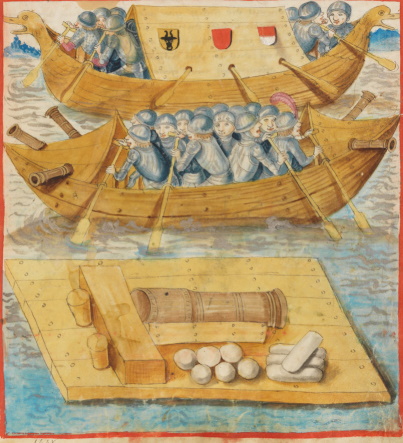
 Attachment: 52.85 KB Attachment: 52.85 KB
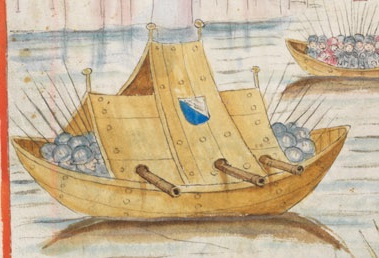
 Attachment: 103.69 KB Attachment: 103.69 KB
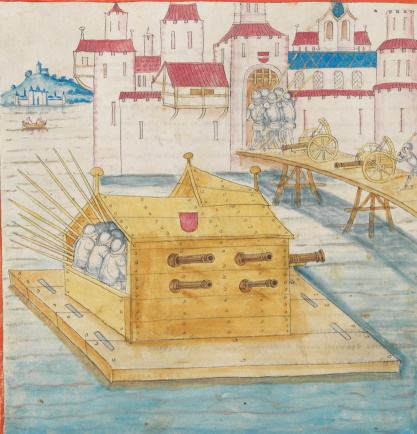
 Attachment: 111.22 KB Attachment: 111.22 KB
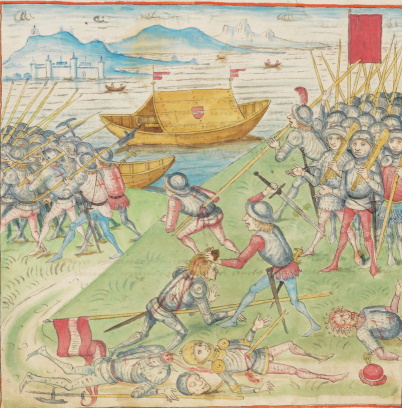
 Attachment: 83.12 KB Attachment: 83.12 KB
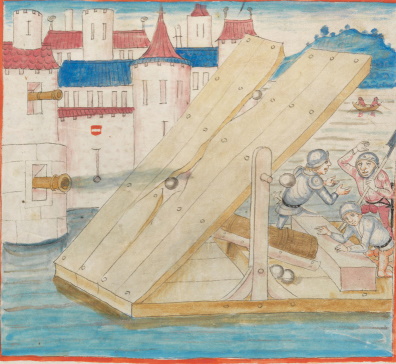
Books and games on Medieval Europe Codex Integrum
Codex Guide to the Medieval Baltic Now available in print
|
|
  |
 |
Pedro Paulo Gaião

|
 Posted: Sat 03 Sep, 2022 6:28 am Post subject: Posted: Sat 03 Sep, 2022 6:28 am Post subject: |
 |
|
| Jean Henri Chandler wrote: | | At the same time, it is also true that many medieval towns, especially the larger ones, proved to be impregnable to even the mightiest siege armies. |
Even with proper artillery train? my doubt is that with enough canons, or at least heavy cannons, you could nulify any type of good walls by opening holes in a short amount of time.
What's your opinion on the Hexamilion Wall? (https://en.wikipedia.org/wiki/Hexamilion_wall#Destruction_of_the_Hexamilion). Probably they were the biggest defensive investment of Constantine XI's reign, but it's said they were annihilated in 5 days of siege! The Siege of Constantinople as well happened within 2 months and they managed to open many holes for the troops to pass through.
| Quote: | | You thought wrong - and I don't know why you would think that? |
Perhaps I was judging based on the Siege of Belgade (1456) where I read only about ships transporting supplies and men.
| Quote: | | Sometimes they carried troops and / or supplies, sometimes guns or cannon, sometimes both. These images are from the old Zurich war on the Zürichsee / Lake Zurich |
I forgot those Swiss illustrations. But I only find evidence for those canon-armed boats and rafts in those manuscripts, was it because they were unsafe? I, at least, wouldn't risk my life fighting with armor on a boat, especially if it has cannon or even worse, over a raft (I have read that few people in this time knew how to swim, and those who recruited tended to not gather people who knew it because they could run away instead of fighting till death.
| Quote: | Pedro, this is a major oversimplification. It's a big and broad subject, but while it's true that some cannon could blast down stone walls, it wasn't so easy or so simple.
Very briefly, town and castle walls started out high so as to be hard to climb over. The first stone walls around cities in the 12th-13th Centuries tended to be high and thin. As various torsion and counterweight artillery improved in the 13th Century, walls got thicker and a little shorter. They got much shorter, thicker and more cleverly shaped as cannon began to be used more and more in the 14th Century. By the 15th, most medieval town walls were pretty well designed and were resistant to cannon balls, but very big cannons / bombards could still in some cases knock them down, which is why the Italians then started making glacis out of earth berms, special star shaped bastions and so on, designing with very careful geometry (which became the so-called Trace Itallienne design type). |
But a castle in higher ground doesn't generally have shorter walls? That's something an architect once told me, beucase the higher it is, the wind and the gravity make it less stable. I
I know that in the 16th century Siege of Buda, the Habsburgs managed to seize the city for themselves, but were unable to seize the Castle on the higher ground (The castle was neglected by the Turks during their occupation and they simply stored gunpowder in it, it eventually exploded in the 1686's Siege as the Habsburg cannons hit the structure and exploded the powder within). Which then reminds me: fortifications in higher ground offer any relevant advantage against canons or the balls hit pretty much the same?
Froissart praises Portuguese fortifications while I, at least as a non-responsible observer, didn't find them to be that impressive (compared to Welsh castles built by King Edward I or the Krak des Chevaliers in Syria, for example). Well, the Castle of São Jorge by Lisbon was held to be impenetrable and impossible to take, but its last relevant siege was in the 1380s, at a time when Joao de Avis disdained canons and thought of them to be unreliable (they used trebuchets instead, Castilians were more Avant-guard, but to no avail); some people think Lisbon's walls were good by that time since King Juan de Trastamara was unable to take them either by canon or by direct assault.

Perhaps Portuguese fortifications before the 16-17th centuries wouldn't acceptable against huge cannons.
| Quote: | | That map you posted is from Braun and Hogenberg almanc Civiites Orbis Terrarum. They were very meticulous in their map designs and typically relied on artists who had recently visited each town in question, sometimes one of the two themselves went to the site of the city to make sketches. So if their map shows a pontoon bridge (which I agree it does) it probably existed. It was also as you noted, probably easy to remove. |
Some later pictures do show the bridge being partly removed. What I didn't noticed until yesterday (the day Buda was taken from the Ottomans) was that in the 1686's it appeared the city was well fortified:
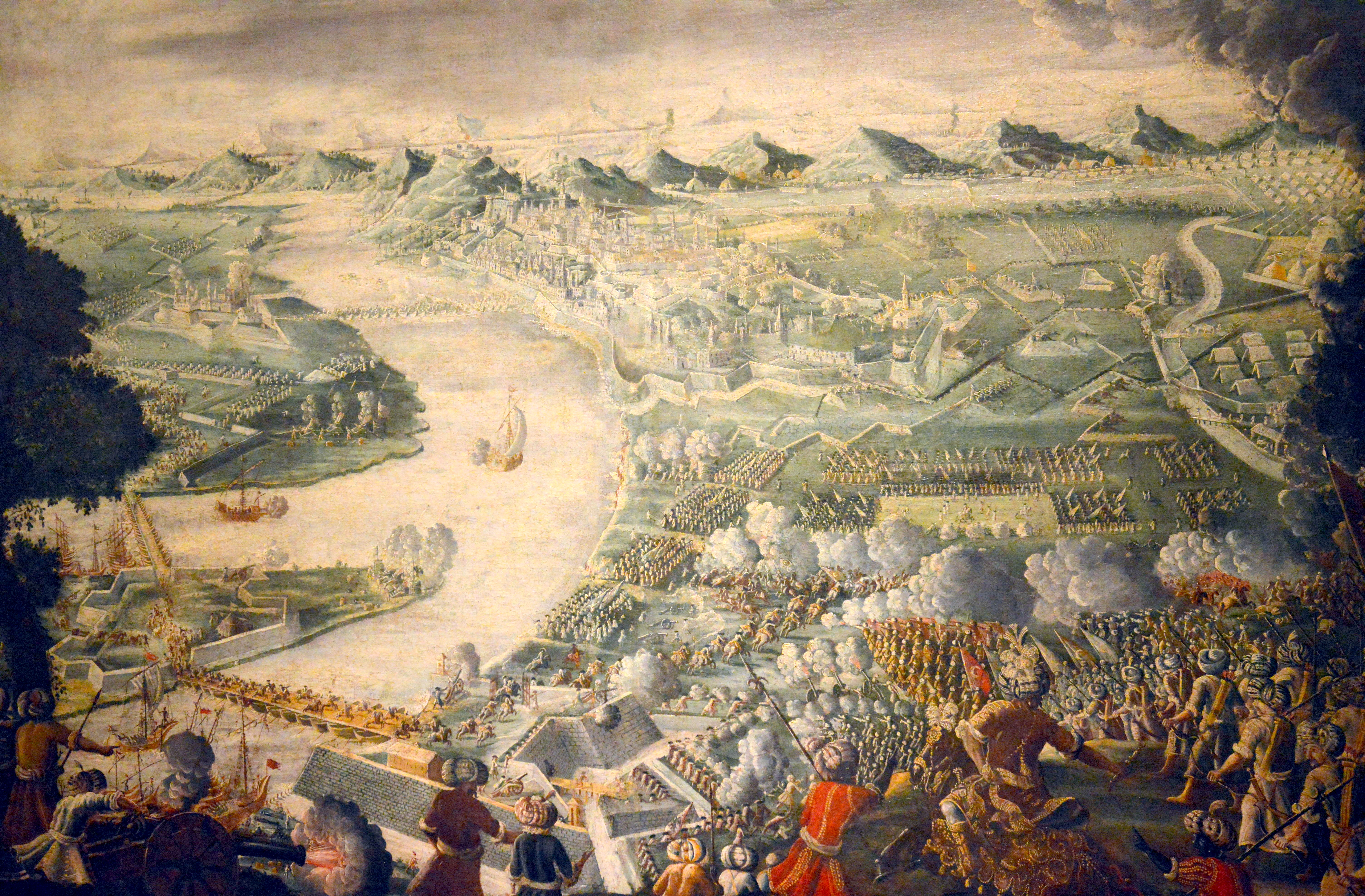
They covered the riverside with walls, and there's a river bordering the opposite side of the city (at least i didn't see that in earlier illustrations. Even Margaret's Island is fortified, though it's probably the besiegers work (though they must have done this in 2-3 months).
“Burn old wood, read old books, drink old wines, have old friends.”
Alfonso X, King of Castile (1221-84)
|
|
  |
 |
Victor R.

|
 Posted: Sat 03 Sep, 2022 7:48 am Post subject: Posted: Sat 03 Sep, 2022 7:48 am Post subject: |
 |
|
Unique up on them.
.
.
.
.
.
.
.
.
.
.
.
.
.
.
.
.
.
.
.
.
.
.
.
.
.
Apologies if you don't know the joke.
|
|
  |
 |
Jean Henri Chandler

|
 Posted: Sat 03 Sep, 2022 8:21 am Post subject: Posted: Sat 03 Sep, 2022 8:21 am Post subject: |
 |
|
| Pedro Paulo Gaião wrote: |
Even with proper artillery train? my doubt is that with enough canons, or at least heavy cannons, you could nulify any type of good walls by opening holes in a short amount of time. |
There were basically two strategies in use from the late medieval and into the Early Modern period for dealing with cannon: Improve the fortifications such that the cannon are relatively ineffective, which is what evolved into the 'Trace Italienne' type bastion fortress, (which utilized massive earthen 'glacis' to absorb cannon balls in addition to other features)...

(Compare the city of Strasbourg from the Nuremberg Chronicle circa 1495...

...with the same city during the 30 years War)

...the second was to build many cannon, including enormous cannon which could out-range whatever the enemy was bringing. By the late 1300s and early 1400s many towns had built enormous bombards which could smash anything any invading army was likely to bring, especially since the towns themselves tended to be far advanced in metallurgy and cannon forging.
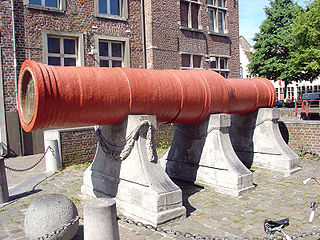
For example this (above) is the cannon "Dulle Griet" forged by Ghent in the early 1400s, which is on a scale approaching that of the largest ottoman cannon made half a century or more later. Generally speaking, a town needed both relatively up to date fortifications, and a substantial and modern arsenal of cannon and guns, in order to remain impregnable.
This approach led to what was later called the "artillery fortress".
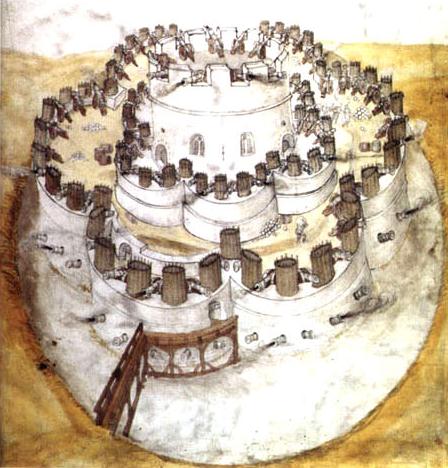
This is kind of an early version of the idea from a 16th Century war-book, (I think this is Walmer castle in Kent but I'm not certain). Note the use of earth filled gabions, invented in the early 15th C (or maybe earlier) to absorb cannonballs. They are ingenious, you just need to carry a wicker sheet rolled up, when you get to your site you unroll it and fill with earth. They are extremely effective in absorbing ballistic energy, in fact we still use these.
There is of course, still no certainty that a town can hold out against a given army. Everything has to be taken care of- there must be enough supplies, the defense must be led by competent commanders, the militia must be trained, ready and well equipped, the fortifications must be up to date and the town needs it's own artillery. Strasbourg itself was taken without much fighting by Louis XIV, but only because he was able to move up almost his whole army while the Holy Roman Emperor was seriously distracted by a major Ottoman invasion and the second Ottoman siege of Vienna and had his whole army in Austria. Heavily (and effectively) fortifying a town just means that it was well protected and therefore takes more men and materiel, more of whom will likely be lost, to capture it.
I posted this before but it's worth looking at if you missed it, this is pretty succinct and covers a lot about fortifications and towns in Central Europe, the amount of money they spent and efforts they went through, how defense was organized etc..
https://deremilitari.org/2014/03/towns-and-defence-in-later-medieval-germany/
It's also worth repeating Machiavelli's pithy comments on the defenses of the "German" towns in his day, which summarizes the situation quite well at that time:
German cities are completely independent, don't have much territory around them and obey the emperor only when it suits. They are not afraid of him, nor of any other powerful rulers in the area. This is because these towns are so well fortified that everyone realizes what an arduous, wearisome business it would be to attack them. They all have properly sized moats and walls; they have the necessary artillery; they have public warehouses with food, drink and firewood for a year; what's more, to keep people well fed without draining the public purse, they stock materials for a year's worth of work in whatever trades are the lifeblood of the city and whatever jobs the common folk earn their keep with. They hold military exercises in high regard and make all kinds of arrangements to make sure they're routinely practised.
Some towns (and other fortifications) proved difficult to defend and tended to be taken over and over. Rome, for example or Jerusalem both fell many times. Others proved to be virtually impregnable and famously resisted repeated sieges. Malbork castle in Prussia (today Poland), which withstood multi-year long sieges more than once; Gdansk / Danzig (in 1577 and 1655-1660), Krakow (1287,1587), Breslau / Wroclaw (1474), and Nuremberg all withstood heavy sieges by large armies. Prague famously withstood sieges even after her outer walls were overrun. The tiny town of Neuss was able to withstand a siege by almost the whole army of the Charles the Bold in 1474-75 (albeit with help from the other Rhennish cities). Charles had one of the best artillery trains in the world at that time. Vienna of course withstood two Ottoman sieges, albeit with a lot of help, from one of the largest and best equipped armies in the world to that point.
Many of the great cities of Central and Northern Europe even managed to get through the apocalyptic 30 years war relatively unscathed in spite of sieges. For example in 1632 one of the greatest generals of the Pike and Shot era, Gustavus Adolphus, attempted to besiege Nuremberg with 45,000 men and 175 field guns, but failed. Others sieges succeeded as the defenders failed in their defense of course, notably Magdeburg, and suffered the terrible fate so common during that awful war.
When it comes to any kind of fortification, the location of the site matters a lot too. This is the main reason (I think) why some towns like say, Bergen, got sacked over and over, while others (like Gdansk, Constantinople or Malbork castle) remained impregnable for centuries.
| Quote: | | What's your opinion on the Hexamilion Wall? (https://en.wikipedia.org/wiki/Hexamilion_wall#Destruction_of_the_Hexamilion). Probably they were the biggest defensive investment of Constantine XI's reign, but it's said they were annihilated in 5 days of siege! The Siege of Constantinople as well happened within 2 months and they managed to open many holes for the troops to pass through. |
I think this is one of those places that isn't blessed by geography for good defense, and too much ground to cover for the defenders.
| Quote: |
Perhaps I was judging based on the Siege of Belgade (1456) where I read only about ships transporting supplies and men. |
I recommend to read a bit more about that, armed river boats played a very important role in that entire campaign.
| Quote: | | I forgot those Swiss illustrations. But I only find evidence for those canon-armed boats and rafts in those manuscripts, was it because they were unsafe? I, at least, wouldn't risk my life fighting with armor on a boat, especially if it has cannon or even worse, over a raft (I have read that few people in this time knew how to swim, and those who recruited tended to not gather people who knew it because they could run away instead of fighting till death. |
I would say no, there is nothing particularly unusual about the Swiss vis a vis boats, if anything they had fewer miles of navigable rivers than most other regions in Europe, though several largeish lakes. The only unusual thing about the Swiss here is that they made all these lavishly illustrated chronicles which have pictures of just about everything basically like giant graphic novels of their history (and the history of a lot of Latin Europe around them), and these chronicles have mostly been scanned and are available online so easy to link to. I myself have downloaded many of these images so I use them a lot, because people seem to remember images but struggle to notice words sometimes... a picture is worth a thousand or so they say. As you are no doubt well aware, I try to use images of period artwork or photos of surviving architecture and artifacts a lot in my posts (and my books) partly to get the point across, and partly because there are often things in these kinds of images that we all miss (myself included). But there are many other sources like this, some with illustrations some just (sadly) text. They are just not as convenient to link to or use in a forum post, more likely in an academic paper or a book as it takes a bit of work to track them down etc..
I have however already pointed out to you several other regional conflicts with sources that cover the use of war boats, including by the Black Army (and their predecessors) in Hungary and the Balkans (particularly on the Danube), and by the Poles and Prussian Confederation in what is now Poland notably along the Vistula. War boats were also used on the Rhine, the Oder, the Dnieper and Don by the Cossacks, and many other rives around Europe.
Most medieval towns incidentally also incorporated rivers and canals into their defenses, as I noted before, which made the old method of tunneling under walls a lot more difficult.
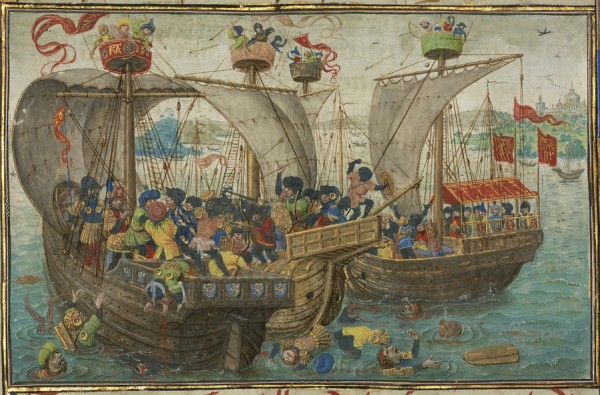
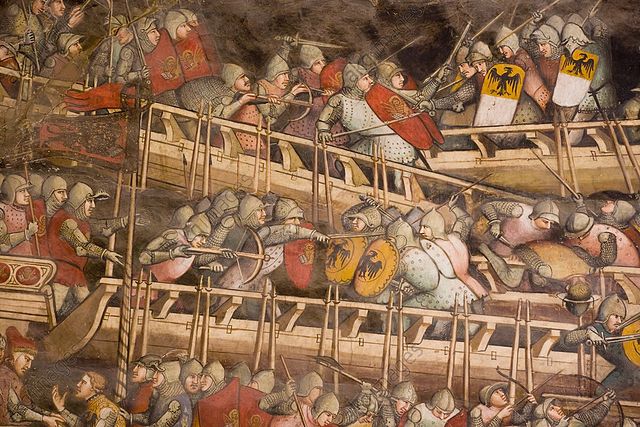
As for wearing armor on ships and boats, I agree it seems quite perilous, but war is perilous regardless, and it also seems to have been the normal practice in the 1300-1500s. I guess you have to weigh the risks of drowning vs. being shot or run through with a spear.
| Quote: | But a castle in higher ground doesn't generally have shorter walls? That's something an architect once told me, beucase the higher it is, the wind and the gravity make it less stable. I
I know that in the 16th century Siege of Buda, the Habsburgs managed to seize the city for themselves, but were unable to seize the Castle on the higher ground (The castle was neglected by the Turks during their occupation and they simply stored gunpowder in it, it eventually exploded in the 1686's Siege as the Habsburg cannons hit the structure and exploded the powder within). Which then reminds me: fortifications in higher ground offer any relevant advantage against canons or the balls hit pretty much the same? |
I think having the higher ground helps in many ways, first of all in seeing the enemy, but it also does help with range of missiles too.
| Quote: |
Froissart praises Portuguese fortifications while I, at least as a non-responsible observer, didn't find them to be that impressive (compared to Welsh castles built by King Edward I or the Krak des Chevaliers in Syria, for example). Well, the Castle of São Jorge by Lisbon was held to be impenetrable and impossible to take, but its last relevant siege was in the 1380s, at a time when Joao de Avis disdained canons and thought of them to be unreliable (they used trebuchets instead, Castilians were more Avant-guard, but to no avail); some people think Lisbon's walls were good by that time since King Juan de Trastamara was unable to take them either by canon or by direct assault. |

Krak des Chevaliers looks magnificent, I agree, but as I noted before, it matters a lot where a castle is made as well as how well it is made. Le Krak was built on relatively soft ground and was taken by the Mamluks under Baibers after a relatively short siege of 36 days in 1271, by using tunneling / mining.
| Quote: | 
Perhaps Portuguese fortifications before the 16-17th centuries wouldn't acceptable against huge cannons. |
I'm sure there are very good forts in Portugal, as the Portuguese were notably successful warriors (particularly at sea), and that one you linked looks very tough, though it has the square shaped towers which are one of the features which were abandoned as cannon became more common, to be replaced by hexagonal or circular / round towers. Cannons could shoot at the corners of square towers and damage them much more quickly. I agree that particular fortification was probably designed to 14th Century standards.
Spanish and Portuguese fortifications seemed to be quite good in many cases. Perhaps the longest siege I ever heard of was the 30 year siege of Ceuta in 1694-1727
| Quote: |
Some later pictures do show the bridge being partly removed. What I didn't noticed until yesterday (the day Buda was taken from the Ottomans) was that in the 1686's it appeared the city was well fortified:

They covered the riverside with walls, and there's a river bordering the opposite side of the city (at least i didn't see that in earlier illustrations. Even Margaret's Island is fortified, though it's probably the besiegers work (though they must have done this in 2-3 months). |
Looks like you are getting into the weeds on the fortifications there, I'm sure your research is going to be well done for your novel or story. Let me know when it's done, I'll definitely buy a copy!
Books and games on Medieval Europe Codex Integrum
Codex Guide to the Medieval Baltic Now available in print
|
|
  |
 |
|
T. Kew
Location: London, UK Joined: 21 Apr 2012
Posts: 256
|
 Posted: Sat 03 Sep, 2022 1:24 pm Post subject: Posted: Sat 03 Sep, 2022 1:24 pm Post subject: |
 |
|
| Pedro Paulo Gaião wrote: |
But a castle in higher ground doesn't generally have shorter walls? That's something an architect once told me, beucase the higher it is, the wind and the gravity make it less stable. |
These are not relevant concerns really (if they are relevant concerns, the bigger problem is the construction of your castle).
However, if you build on a natural outcropping or cliff, you can generally get away with shorter walls, because the relevant factor for the height of your walls against attack by escalade is how tall they are from the point someone can put up a ladder. When you've got 5m of cliff (for example), then putting 5m of wall on top is often plenty of wall.
On the topic more generally, I think it's worth remembering that fortifications are always a tradeoff between the costs involved and the expected threats being faced. No castle or fortified town can be truly impregnable, given a sufficiently wealthy and motivated opponent - the aim of the game is instead to be sufficiently robustly defended that your likely adversaries are unable to justify the costs involved. This also means that comparing fortifications, particularly across substantial time differences, can become pretty misleading: maybe one castle was much more strongly built, but that doesn't necessarily mean the other one is 'worse'.
HEMA fencer and coach, New Cross Historical Fencing
|
|
  |
 |
|
Ryan S.
|
 Posted: Sun 04 Sep, 2022 9:08 pm Post subject: Posted: Sun 04 Sep, 2022 9:08 pm Post subject: |
 |
|
I don’t think Buda and Pest were that unique. Most cities were built on a river, and while most medieval cities were built on only one side of the river, at some point, I am not sure when, cities expanded to the other side. It probably had to do with the size of the city. In the case of Prague, a small settlement was formed near the castle on the other side of the river. A castle overlooking or nearby a city, but not in it, was also a common feature of medieval towns. This settlement became a town in 1257 and is called the lesser town. It played a role in the siege of Prague in 1648. The Swedes were able to take the Lesser town by surprise in the night, including the castle. Apparently, they found a spot on the wall that was weakly defended, and climbed over, defeated the guards and opened the gate. From there out, they launched several attempts to take Prague itself, but were repelled by the defenders, made up mostly of militia and students. In 1742 Prague was again taken by surprise, this time by the French who took the whole city and had to defend it in a siege.
In a sense, every city is unique and that affects how it is besieged or attacked. As far as for whom the size of the city gives the advantage, I think that depends. A larger city is harder to encircle, so that it is harder to besiege. It is, however, also harder to defend a large city, when one doesn't have enough troops. In Buda that becomes a problem, because the river divides the city in a way that makes it hard to move troops back and forth. Although, it appears that Buda in the stronger position, in part because of its fortifications, but also because of the hills. So the defender has to decide if he can defend both Buda and Pest, or just Buda. The attacker then has to decide from which direction he attacks. Does he concentrate on Pest first, and then move to Buda? Or ignore Pest and go straight for Buda?
Here is another picture of the siege in 1541, they seem to be fighting in the camp: https://upload.wikimedia.org/wikipedia/commons/9/9d/Buda_in_1541-by_Erhardt_Sch%C3%B6n_from_1542.jpg
Here is a picture of the siege of Pest, in 1542. I found the defences for the camp interesting, but also the chain across the river. The boats all have their sails furled, I wonder how they move and if they go against the current.

|
|
  |
 |
|
|
You cannot post new topics in this forum
You cannot reply to topics in this forum
You cannot edit your posts in this forum
You cannot delete your posts in this forum
You cannot vote in polls in this forum
You cannot attach files in this forum
You can download files in this forum
|
All contents © Copyright 2003-2025 myArmoury.com — All rights reserved
Discussion forums powered by phpBB © The phpBB Group
Switch to the Basic Low-bandwidth Version of the forum
|

